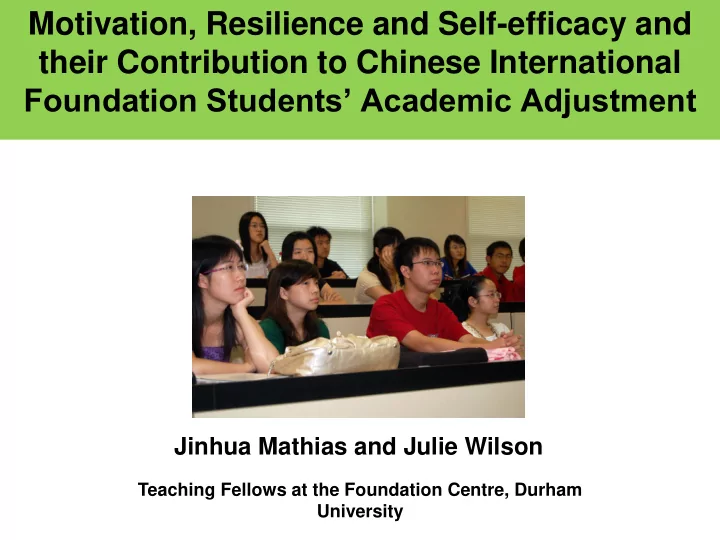

Motivation, Resilience and Self-efficacy and their Contribution to Chinese International Foundation Students’ Academic Adjustment Jinhua Mathias and Julie Wilson Teaching Fellows at the Foundation Centre, Durham University
Introduction and outline A study of Chinese international foundation students’ academic adjustment. Background of the study Method: questionnaire Results and discussion Limitation Summary Implications of the study
Background of the study The Background Number of Chinese students in UK nearly 90000 in 2014 Wide range of degrees Biggest challenge? Contributing factors to success
Background of the study Motivation, motivation, motivation Level of motivation – self motivated to being motivated by others Types of motivation – intrinsic to extrinsic Chinese students’ motivation to study abroad has two primary sources: the motivation to have an education abroad as opposed to home ( Pull and push factor), personal motivation to study a subject (intrinsic or extrinsic).
Background of the study Resilience Resilience: resourcefulness, self-confidence, self- discipline, sensibleness, adaptability, and flexibility (Giordano, 1997) Seven personal resilience characteristics (Wang, 2009): positive world view (PWV), positive self-concept (PSC), focused sense of purpose (FSP), flexible thinking (FT), social flexibility (SF), organising ambiguity (OA) and proactivity (Pro)
Background of the study General self-efficacy Self- efficacy: an individual’s confidence or belief in one’s ability to effectively engage in behaviours toward one’s desired goal (Bandura, 1997) Study showed that academic self-efficacy and optimism were strongly related to performance and adjustment.
Background of the study It is also important to know, 39.4 times the size of UK 55 ethnic minorities 3,200 miles 7 main linguistic groups 3,400 miles Nearly 300 local dialects Educational differences - eg.“GaoKao” “I was more shocked by south -north difference (within China) than east- west difference (China/UK).” (Zhao, S.)
The Aim Aim of the study Foundation students’ motivation Contribution to the academic adjustment of Chinese international students.
Method Sample (57 students from academic year of 2012-2015) Data collection instrument: creating the questionnaire Motivation -- “The university student Motivation and Satisfaction Questionnaire version 2”, by Neill (2004). Personal Resilience -- based on ODR’s Personal Resilience framework, as cited in Wang (2009). General Self-Efficacy (GSE) (Luszczynska, Gutiérrez ‐ Doña & Schwarzer, 2005) Adjustment -- relating to adjustment to teaching and learning, assessment and time management, communication and group work , etc.
Method Data collection instrument: questionnaire To ensure reliability, we repeated questions in different ways All translated into Chinese and tested on former Chinese Foundation students Received many helpful suggestions Final version of questionnaire distributed twice in the academic year
Results and discussion Students’ primary sources of motivations (2012 -15) Motivation No. of students (out of 57) Self exploration (SE) 26 Altruism (AT) 22 Instrumental attraction (IN-AT) 29 Instrumental avoidance (IN-AV) 5 Hedonism (HE) 21 Self image attraction (SI-AT) 12 Self image avoidance (SI-AV) 8
Results and discussions Correlation of motivation with academic adjustment (2012-15) Type variables Pearson Correlation for Academic adjustment End of term Begin. of term Self – exploration (SE) Motivation Intrinsic 0.418** 0.371** Altruism (AT) 0.387** 0.241 Extrinsic Instrumental value attraction (IN-AT) 0.026 -0.059 Instrumental value avoidance (IN-AV) -0.029 -0.129 Hedonism (HE) 0.112 -0.167 Self-image attraction (SI-AT) 0.126 0.079 Self-image avoidance (SI-AV) -0.089 -0.062
Results and discussions Correlations of resilience and self-efficacy with academic adjustment (2012-15) Variables Pearson Correlation for Academic adjustment End of term Beginning of term Resilience 0.457* 0.067 Positive World View (PWV) 0.502** 0.162 Positive Self-Concept (PSC) 0.448* 0.403** Focused Sense of Purpose (FSP) 0.515** 0.223* Flexible Thinking (FT) 0.413** 0.269 Social Flexibility (SF) 0.587** 0.414** Organising Ambiguity (OA) 0.682** 0.442** Proactive (Pro) General Self Efficacy General Self-efficacy (GSE) 0.508** 0.297**
Results and discussions Motivation (intrinsic) Resilient Self-efficacy R=0.264 Pearson product for partial correlations (** indicating p<0.01)
Results and discussions Motivation Academic Adjustment (intrinsic) Personal resilience Self-efficacy
Limitations of the study Number of students Background of students Lack of qualitative data
Summary of findings Combination of motivating factors However, findings indicate that only intrinsic motivation contributes to academic success All have a positive effect on academic adjustment It seems that they are not internally correlated
Implications of the study Asking the right questions could improve success rates. For Recruiters Could be useful additional indicators for good academic adjustment For Student Support Could identify potential problems in Induction Week Appropriate support (such as peer mentoring) could be utilised
Recommend
More recommend